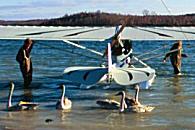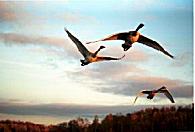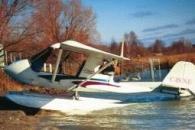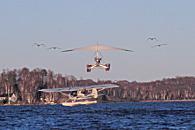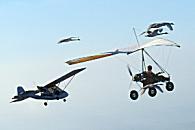|
A hundred years ago the last wild Trumpeter Swans disappeared from Eastern North America. Pot hunting and skin trading eradicated the birds directly while the draining of marshes did so indirectly, by eliminating their nesting grounds. To reintroduce the species, several thousand
Trumpeter Swans have been raised for live release in Canada and the United
States. Due to the 100 year absence of Trumpeter Swans from eastern North America, none of the released birds have exhibited migratory behaviour. For the reintroduction to be sustainable, the migration route between summering and wintering areas must be taught to the first new generation. Three such migrations have been induced in Canada Geese through the use of land-based ultralight aircraft. Similar efforts with Trumpeter Swans have been hampered by a lack of appropriate habitat and the availability of suitable amphibious aircraft. Unlike geese, the swans only learn to fly off water. The Migratory Bird Research Group,
lead by Wayne Bezner Kerr, embarked in 1996 on a three year project to
establish a self-sustaining migratory population of Trumpeter Swans. The group secured protected nesting and rearing grounds in Ontario and purchased a Challenger II on Puddlejumper amphibious floats as well as a trike on straight floats to work with the swans. The Challenger was selected in part for its extremely short takeoff and landing performance on water as well as its maneuverability over a wide operating speed range, from very slow to very fast. The Challenger operates in two capacities.
In 1997 the project made significant progress towards its ultimate objective. Eggs from the Yukon were hatched near Toronto and the cygnets were initially raised in a secluded pond. Later in the summer they were moved to a lake near Sudbury, Ontario, where they were conditioned to fly with the airplane. The combination of a month late hatch (a consequence of unfavourable spring weather) and an early freeze-over did not afford the birds sufficient time to build the endurance necessary for a migration in 1997. In 1998 new cygnets were hatched and intensive training was again conducted near Sudbury.
At the destination the humans and airplanes departed, leaving the birds to fend for themselves in the wild. On several occasions during the winter, rangers spotted the swans foraging in the wetlands of the refuge. In the spring of 1999 some of the swans were sighted back in Sudbury. Another sighting occurred near Sudbury in the spring of 2000. These sightings prove the viability of the project's methodology. Currently the team is seeking sponsors to migrate a much larger flock which is crucial to re-establishing self-sustaining migratory Trumpeter Swans in eastern North America. There are more pictures of the Swans and the Challenger in the Family Album. You can also read an account by Wayne Bezner Kerr in Air Sports International.
To learn and see more order our comprehensive information package and video! |
